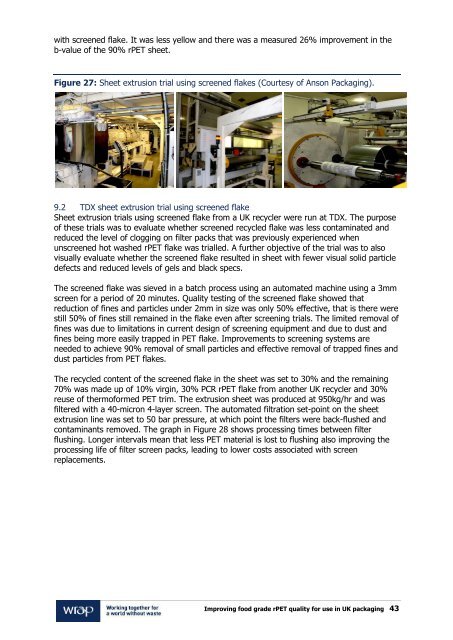rPET Quality Report
You also want an ePaper? Increase the reach of your titles
YUMPU automatically turns print PDFs into web optimized ePapers that Google loves.
with screened flake. It was less yellow and there was a measured 26% improvement in the<br />
b-value of the 90% <strong>rPET</strong> sheet.<br />
Figure 27: Sheet extrusion trial using screened flakes (Courtesy of Anson Packaging).<br />
9.2 TDX sheet extrusion trial using screened flake<br />
Sheet extrusion trials using screened flake from a UK recycler were run at TDX. The purpose<br />
of these trials was to evaluate whether screened recycled flake was less contaminated and<br />
reduced the level of clogging on filter packs that was previously experienced when<br />
unscreened hot washed <strong>rPET</strong> flake was trialled. A further objective of the trial was to also<br />
visually evaluate whether the screened flake resulted in sheet with fewer visual solid particle<br />
defects and reduced levels of gels and black specs.<br />
The screened flake was sieved in a batch process using an automated machine using a 3mm<br />
screen for a period of 20 minutes. <strong>Quality</strong> testing of the screened flake showed that<br />
reduction of fines and particles under 2mm in size was only 50% effective, that is there were<br />
still 50% of fines still remained in the flake even after screening trials. The limited removal of<br />
fines was due to limitations in current design of screening equipment and due to dust and<br />
fines being more easily trapped in PET flake. Improvements to screening systems are<br />
needed to achieve 90% removal of small particles and effective removal of trapped fines and<br />
dust particles from PET flakes.<br />
The recycled content of the screened flake in the sheet was set to 30% and the remaining<br />
70% was made up of 10% virgin, 30% PCR <strong>rPET</strong> flake from another UK recycler and 30%<br />
reuse of thermoformed PET trim. The extrusion sheet was produced at 950kg/hr and was<br />
filtered with a 40-micron 4-layer screen. The automated filtration set-point on the sheet<br />
extrusion line was set to 50 bar pressure, at which point the filters were back-flushed and<br />
contaminants removed. The graph in Figure 28 shows processing times between filter<br />
flushing. Longer intervals mean that less PET material is lost to flushing also improving the<br />
processing life of filter screen packs, leading to lower costs associated with screen<br />
replacements.<br />
Improving food grade <strong>rPET</strong> quality for use in UK packaging 43



